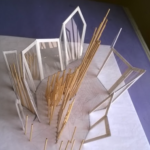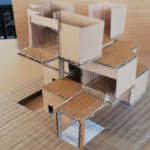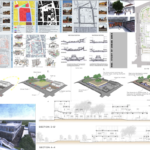Interpretation of Syllabus
The Syllabus prescribed by the SPPU (Savitribai Phule Pune University) to which the School is affiliated covers a number of aspects related to the field of Architecture. While Design and Construction Technology form the core of Architectural education, they are complemented by various theory and Studio courses throughout the five years. Courses prescribed under the syllabus could be loosely grouped under five heads viz. Design, Technology, Skills, Humanities and Research. In addition to these, electives are offered to add value to the main course curriculum and bring in different approaches from parallel fields.
At Aayojan, we go beyond this prescribed outline both in letter and in spirit. Each Studio and theory class strives to interpret the syllabus in a manner that is both relevant to the current scenario in the field and also challenging to the current set of learners. A number of parallel subjects like Art, Sociology, Anthropology, etc. are also introduced through lectures, presentations and workshops.
The syllabus thus becomes a broad framework within which Aayojan encourages exploration and experimentation in teaching and learning Architecture.
FIRST YEAR

SEMESTER 1
The First semester aims to introduce students to the basics of architecture, specially pertaining to elements and principles of design, the primary building materials, their behaviour and forces acting on them, and the way these materials are used to construct buildings. Students are also introduced to historical civilisations and the way architecture was shaped then. A major part of the teaching-learning process involves building their skills of visualisation, graphical representation and model making.
Basic Design
Building Construction and Materials – I
Theory of Structures – I
Architectural Graphics and Drawing – I
History of Architecture and Culture – I
Communication Skills
Workshop – I

SEMESTER 2
In the second semester, the students begin to design buildings of a simple nature by studying a primary settlement. There is a seamless integration of what the students learn in theory about timber as a building material and various components made in it, what they see during the settlement study and later what they apply in design. The aspect of honing the various skills still continues.
Architectural Design – I
Building Construction and Materials – II
Theory of Structures – II
Architectural Graphics and Drawing – II
History of Architecture and Culture – II
Fundamentals of Architecture
Workshop – II
SECOND YEAR

SEMESTER 3
As the students now start to design progressively complex structures, they are introduced to more technical aspects (one at a time) that need to be considered while designing an architectural project. These include aspects of climate and building services. The technical subjects run parallel to design and aid in their undertstanding of structures and construction. History deals with the evolution of arches and domes in the European context.
Architectural Design – II
Building Construction and Materials – III
Theory of Structures – III
Computer Aided Design and Graphics
Building Services – I
Climatology
History of Architecture – III

SEMESTER 4
As the students are now more comfortable with the process of design, they are introduced to the idea of context in Architectural Design. A settlement study in an identified historical city is the starting point of the design process. History aids in teaching them the theoretical concepts for a contextual study and linking it with contemporary architecture. For a holistic development, the students are expected to apply the learings of various subjects into design.
Architectural Design – III
Building Construction and Materials – IV
Theory of Structures – IV
Environmental Science
Building Services – II
History of Architecture – IV
Site Surveying and Analysis
THIRD YEAR

SEMESTER 5
In this semester students start looking at architecture beyond a single building. They learn to integrate the inside and outside spaces. At this same time they get an insight into dealing with details related to interior spaces, be it furniture or services for ventilation. Through the history of contemporary architecture, they get an insight into the current practices in architecture. They also get to know about the necessary drawing requirements for on site construction of a G+1 RCC structure.
Architectural Design – IV
Building Construction and Materials – V
Theory of Structures – V
Landscape Architecture
Working Drawing – I
Building Services – III
Elective – 1 (Contemporary Architecture)

SEMESTER 6
In this semester the scale of the projects being handled by students increases further. They learn about necessary services in multi-storied structures, and how to design keeping them in consideration. They start looking at interior spaces in a holistic manner. With most of the basic required information passed on to students till now, this semester trains the students to start developing their own opinion about architecture. This semester which comes at the midway in the 5 year journey, is important since it prepares the student to handle a medium scale structure in almost all aspects.
Architectural Design – V
Building Construction and Materials – VI
Theory of Structures – VI
Research in Architecture – I
Elective – II
Building Services – IV
Working Drawing – II
FOURTH YEAR

SEMESTER 7
In this semester, students are introduced to ancillary topics related to Architecture, along with practical aspects of the field and professional practice like laws, tendering, estimation and writing of specifications and conduct and responsibilities as a professional. They are also exposed to the complex design parameters of large – scale, multi – functional or service – intensive buildings, and basic concepts of urban development and planning.
ARCHITECTURAL DESIGN VI
ADVANCED BUILDING CONSTRUCTION AND SERVICES I
URBAN STUDIES I
RESEARCH IN ARCHITECTURE II
ELECTIVE III
QUANTITY SURVEYING & SPECIFICATION WRITING I
PROFESSIONAL PRACTICE

SEMESTER 8
This Semester builds upon and continues the topics introduced in the last semester, with regards to the design and estimation of multi – functional and service – intensive buildings and professional practice. The students are also introduced to the relationship of allied fields such as sociology and music with architecture; and the process of urban design through documentation and analysis of a surburb – level urban fabric, and introduction of an appropriate urban insert in the same.
ARCHITECTURAL DESIGN VII
ADVANCED BUILDING CONSTRUCTION AND SERVICES II
URBAN STUDIES II
ELECTIVE IV
ELECTIVE V
QUANTITY SURVEYING & SPECIFICATION WRITING II
PROJECT MANAGEMENT
FIFTH YEAR

SEMESTER 9
Gaining a practical understanding of the field of architecture is the primary aim of the subject. The student interns with an architect of their choice in the field of their inclination for a period of 100 to 120 days and gains insight of the application of the learned concepts and theories in the actual world. At the end of the internship, the student is to present their work (done in the office) and share their learning.
Practical Training

SEMESTER 10
The Final Year of the Architecture course prepares students to apply all that they have learnt in the previous years. It offers them an opportunity to explore their ideas, skills and knowledge through an Architectural Design project of their liking and choice. The process starts from identifying an issue or need to be addressed, formulating a brief for the project, identifying an appropriate site, analysing the physical and socio- cultural context and coming up with an appropriate and sensitive design response under the guidance of Faculty.
Elective IV – Management Elective
Architectural Design Project


